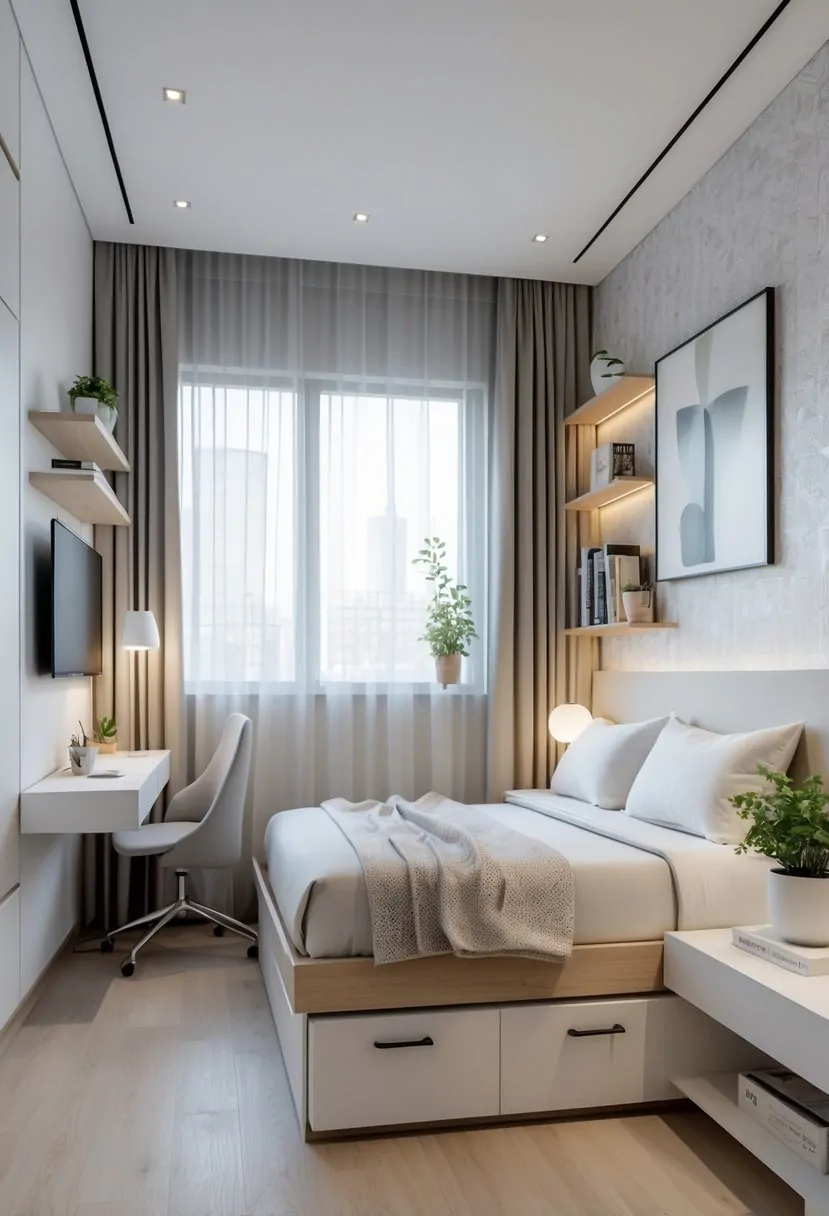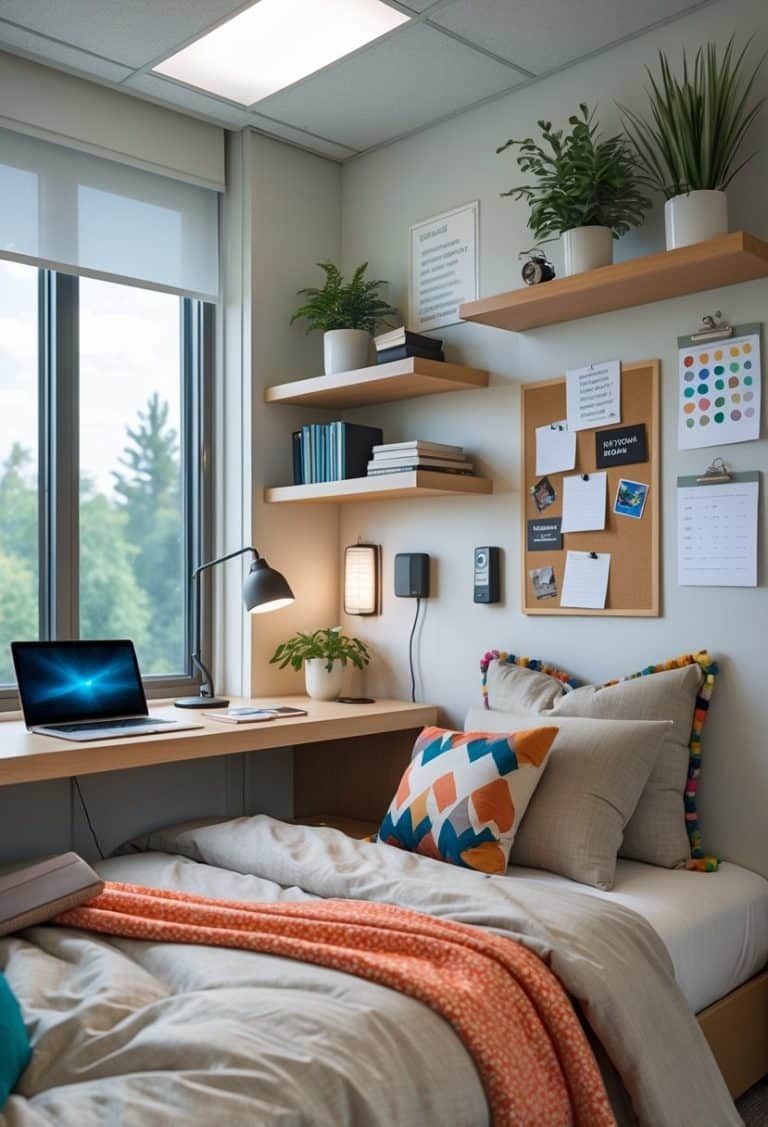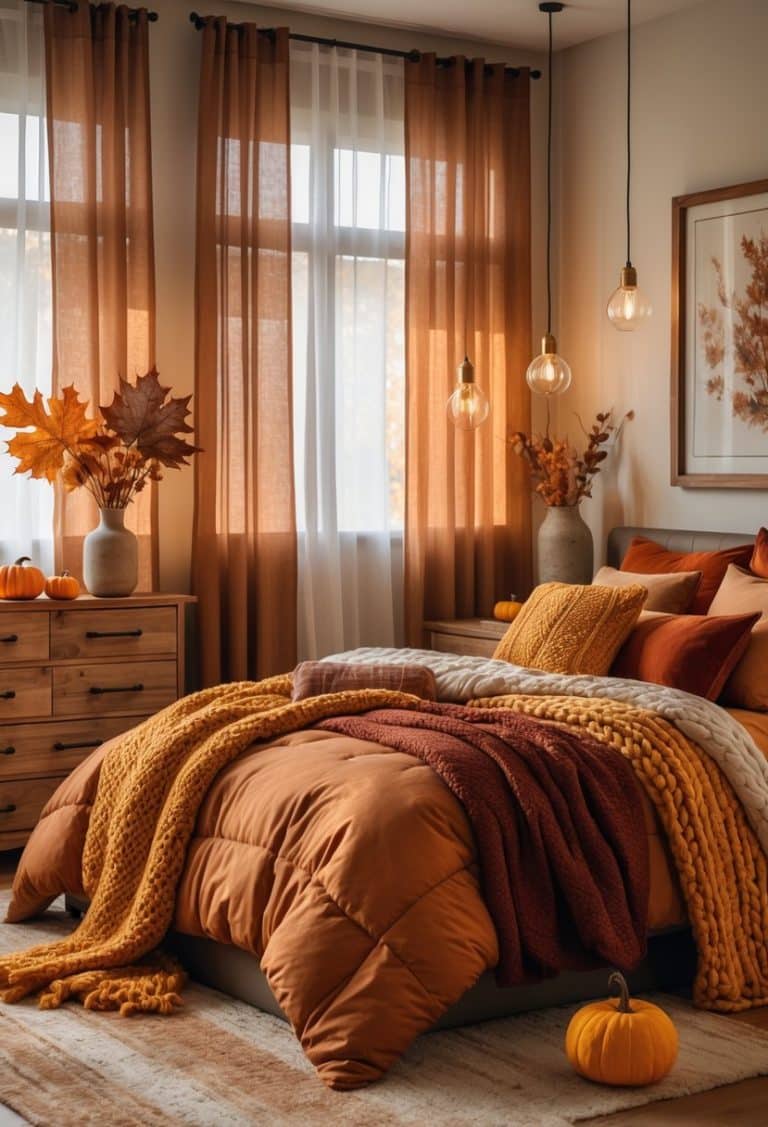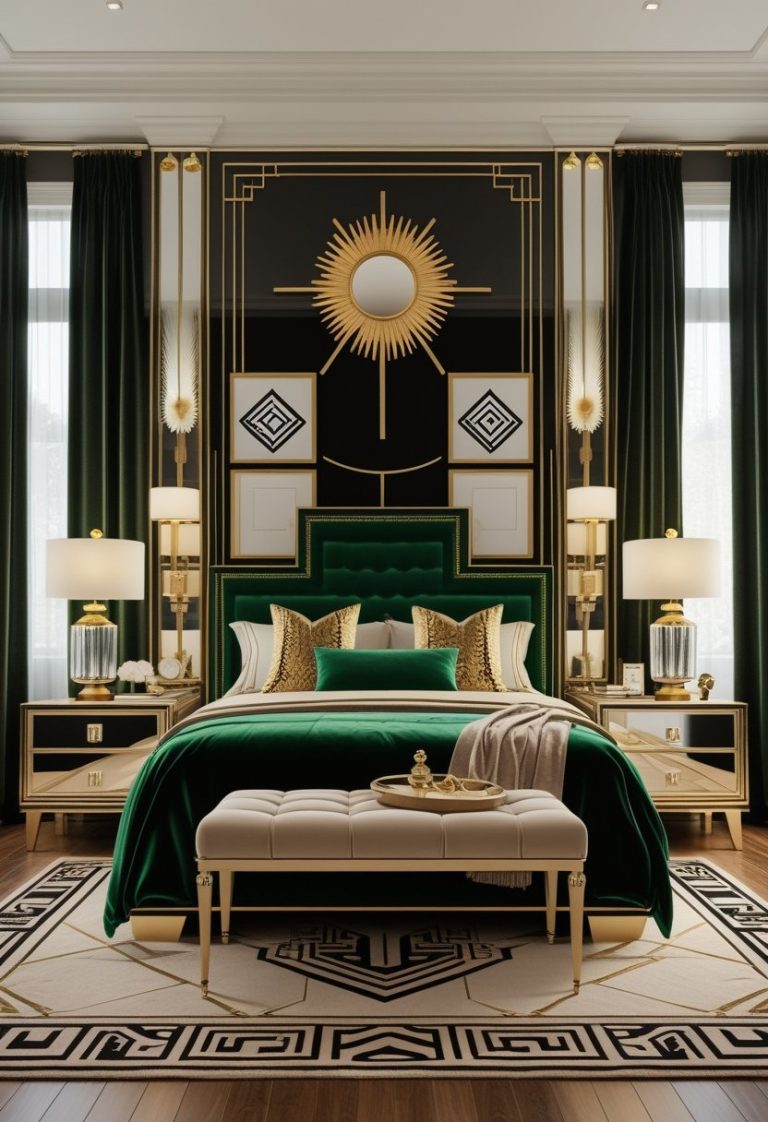Small Bedroom Ideas 2026: 22 Smart Ways To Maximize Space And Style

Small bedrooms continue to evolve in 2026 with a focus on comfort, efficiency, and clean design. People want spaces that feel larger without sacrificing function or style. This guide shows how thoughtful furniture choices, color use, and layout planning can make even the smallest rooms feel open and practical.

Modern design trends highlight smart storage, light tones, and minimal clutter to create calm, livable spaces. Every design choice matters—from the type of bed to the placement of lighting. With the right approach, any small bedroom can become both stylish and functional.
Use multi-functional furniture like storage beds

Multi-functional furniture helps small bedrooms stay organized and open.
A storage bed adds hidden space for clothes, bedding, or seasonal items without taking up extra floor area.
They can pair it with other dual-purpose pieces, like a desk that folds away or a nightstand with drawers, to make the room more efficient.
Install floating shelves to save floor space

Floating shelves help small bedrooms feel more open by keeping items off the floor.
They provide storage for books, plants, and decor without using bulky furniture.
Installing shelves above desks or beds uses vertical space efficiently and keeps surfaces clear.
Opt for light, neutral paint colors to enlarge the room visually

Light, neutral paint colors make a small bedroom feel more open. Shades like off-white, beige, and pale gray reflect natural light and reduce shadows.
These tones create a calm, balanced look that helps walls seem farther apart. Even soft pastels can add warmth without making the space feel smaller.
Incorporate mirrors to reflect light and create depth

Mirrors help small bedrooms feel brighter by reflecting natural and artificial light.
Placing a large mirror opposite a window spreads daylight across the room.
A mirrored wardrobe or wall panel adds visual depth, making limited space appear more open without adding clutter.
Choose a loft bed to free up space underneath

A loft bed raises the sleeping area, leaving open space below for storage or work.
They can add shelves, drawers, or a desk beneath the bed to keep the room organized.
This setup helps small bedrooms feel less crowded while keeping floor space clear.
Use under-bed storage bins for seasonal items

They can store off-season clothes, shoes, or bedding in flat bins that slide easily under the bed.
This setup keeps items protected and out of sight while freeing up closet space.
Choosing bins with wheels or clear lids helps them find and access stored items quickly when seasons change.
Select slim-profile furniture to avoid bulkiness

Slim-profile furniture helps small bedrooms feel open and organized. Pieces with narrow frames or thin legs reduce visual weight and leave more floor space.
They can choose wall-mounted shelves, compact nightstands, or low-profile beds to maintain balance in the room without crowding the area.
Add wall-mounted bedside lamps instead of table lamps

Wall-mounted bedside lamps free up space on small nightstands and make a room feel less crowded.
They provide focused light for reading or relaxing without taking up valuable surface area.
Adjustable swing-arm designs let users direct light where needed while keeping the layout neat and functional.
Use vertical storage solutions like tall dressers

Tall dressers help save floor space while offering plenty of storage. Their vertical design makes them ideal for small bedrooms with limited square footage.
They keep clothing, accessories, and linens neatly organized. Pairing a tall dresser with wall shelves or mounted hooks can further maximize space and maintain a clean layout.
Incorporate built-in closets to maximize storage

Built-in closets help small bedrooms stay organized without taking up extra floor space.
They can fit into unused corners or along one wall, creating a clean and efficient layout.
Sliding or mirrored doors reduce clutter and make the room feel larger while keeping storage accessible and neat.
Choose bedding with simple patterns to avoid visual clutter

Simple bedding patterns help a small bedroom feel calm and organized.
Solid colors, thin stripes, or subtle geometric designs add interest without making the space look busy.
By keeping patterns minimal, the room appears larger and more open while maintaining a clean, cohesive look.
Use curtains that extend from ceiling to floor to add height

Floor-length curtains make walls appear taller by drawing the eye upward.
When hung near the ceiling, they create a clean vertical line that adds height and balance to small bedrooms.
Light fabrics and soft colors help maintain an open, airy feel while still framing the window neatly.
Place a small desk that doubles as a vanity

A compact desk can serve as both a workspace and a vanity, making it ideal for small bedrooms.
They can add a mirror and small storage drawers to keep makeup and essentials organized.
This setup saves space while keeping the room functional and tidy.
Use sliding doors instead of swinging doors

Sliding doors save space because they move along a track instead of swinging open.
They work well in small bedrooms where every inch matters.
Pocket or barn-style sliding doors also create a clean, modern look while maintaining privacy and easy access.
Incorporate a fold-down wall desk for a home office

A fold-down wall desk helps save floor space in a small bedroom. It folds neatly against the wall when not in use, keeping the room open and uncluttered.
They can install it near a window for natural light or beside a bed for easy access. Simple designs often include shelves or pegboards for storage.
Use light-colored rugs to brighten the floor area

Light-colored rugs make small bedrooms feel more open by reflecting natural and artificial light.
Shades like beige, cream, or soft gray help the floor blend smoothly with the walls, reducing visual clutter.
They also create a calm, balanced look that enhances both brightness and comfort in limited spaces.
Add hooks or pegboards for hanging accessories

Hooks and pegboards help keep small bedrooms organized by using vertical wall space.
They can hold items like hats, jewelry, or bags, keeping surfaces clear.
Pegboards also allow flexible arrangement, so they can adapt as storage needs change.
Use clear acrylic furniture to maintain openness

Clear acrylic furniture helps small bedrooms feel open and uncluttered.
Its transparent design reduces visual bulk, making the room appear larger.
Pieces like acrylic chairs, nightstands, or shelves blend into the space while still providing function and durability.
Choose minimalistic decor to avoid overcrowding

They keep the room open by choosing only essential furniture with clean lines.
Neutral colors and simple textures create a calm, balanced look.
A few well-placed items, like a small lamp or framed artwork, add personality without cluttering the space.
Install dimmable lighting for ambiance control

Dimmable lights let users adjust brightness to match different needs, from reading to relaxing.
They help small bedrooms feel comfortable and flexible without adding clutter.
LED bulbs and smart dimmer switches allow precise control, improving both energy efficiency and mood.
Use a bench with storage at the foot of the bed

A storage bench adds both seating and hidden space for blankets, pillows, or shoes.
It fits neatly at the foot of the bed and helps keep the room organized.
Choosing a design that matches the room’s style keeps the space looking tidy and balanced.
Create a gallery wall with small framed art

They can use small framed art to make a bedroom wall more personal without crowding the space.
Arranging a few pieces in a simple grid or balanced layout keeps the wall neat and easy to update.
Mixing photos, prints, and small drawings adds variety while keeping the look cohesive.
Design Principles for Small Bedrooms

Designing a small bedroom requires a balance of space, light, and color. Smart use of natural light, thoughtful color choices, and visual design techniques help make a compact room feel open, comfortable, and functional.
Maximizing Natural Light
Natural light makes a small bedroom appear larger and more welcoming. Large or unobstructed windows let in more daylight, reducing the need for artificial lighting during the day. Light-filtering curtains or sheer fabrics provide privacy without blocking sunlight.
Mirrors reflect light and distribute it evenly throughout the room. Placing a mirror opposite a window can double the brightness and create a sense of depth.
Furniture placement also affects light flow. Keeping taller pieces away from windows prevents shadows and allows sunlight to reach more areas. Clean window glass and light-colored window frames further enhance brightness.
When natural light is limited, LED lighting with adjustable brightness can mimic daylight and maintain a balanced atmosphere. Layered lighting—such as a mix of overhead, task, and accent lights—ensures consistent illumination in all corners.
Choosing the Right Color Palette
Color influences how spacious and calm a small bedroom feels. Light shades like soft whites, pale grays, and muted pastels reflect light and make walls appear farther apart. A monochromatic color scheme keeps the space cohesive and avoids visual clutter.
Accent colors can add personality without overwhelming the room. Using a darker tone on one wall or through small decor pieces, such as pillows or artwork, introduces contrast and depth.
The finish of the paint also matters. Satin or eggshell finishes reflect more light than matte paints, subtly brightening the space.
To maintain a balanced look, limit the number of main colors to two or three. This approach keeps the design simple and prevents the room from feeling crowded.
Creating Visual Space
Visual space relies on how the eye perceives openness. Using multi-functional furniture—like storage beds or wall-mounted desks—reduces clutter and leaves more floor area visible.
Vertical design elements draw attention upward. Tall shelves, vertical stripes, or elongated headboards make ceilings appear higher.
Keeping pathways clear and choosing furniture with exposed legs helps maintain an airy feel. Transparent or reflective materials, such as glass nightstands or mirrored wardrobes, reduce visual weight.
A few well-placed decor items can add character without overcrowding. Balance is key—each object should serve a purpose or enhance the overall design harmony.
Common Challenges and Solutions

Many small bedrooms struggle with limited floor space and the need for both comfort and function. Practical storage and careful furniture placement help create a balanced room that feels open yet useful.
Storage Without Clutter
Smart storage keeps small bedrooms organized without feeling cramped. Built-in drawers under the bed or lift-up storage frames use space that would otherwise go unused. Wall-mounted shelves or floating nightstands free up floor area and make cleaning easier.
Closets benefit from vertical organization. Adding double hanging rods, slim bins, and over-the-door racks helps store more in less space. Clear boxes or labeled baskets maintain order and make items easy to find.
A small table below a wall mirror can double as a vanity and desk. This type of multifunctional furniture reduces clutter while maintaining style.
| Storage Idea | Benefit |
|---|---|
| Under-bed drawers | Hidden storage for clothes or linens |
| Floating shelves | Keeps surfaces clear |
| Foldable bins | Easy to move and store |
Furniture Arrangement Tips
Arranging furniture in a small room requires balance between comfort and movement. Placing the bed against one wall or centered under a window opens up walking space. Choosing slim-profile furniture with exposed legs helps the room look larger.
Avoid blocking natural light. Keeping windows clear and using light curtains brightens the area and reduces visual weight.
If space allows, a foldable desk or wall-mounted drop table works for work or study without crowding the room. Matching furniture scale to room size prevents a heavy look and keeps proportions comfortable.
Simple layouts with fewer, well-chosen pieces usually feel more open and calm than rooms filled with oversized furniture.






